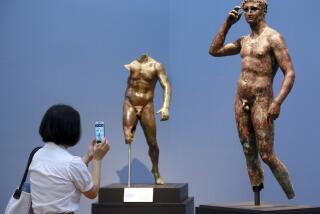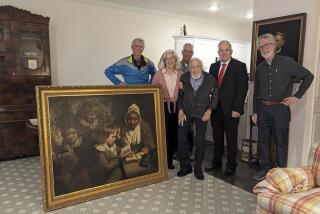Getty Museum Acquires Renaissance Masterpiece
Nearly six months after making a $22.5-million bid to buy Fra Bartolommeo’s painting “The Holy Family With the Infant St. John,” the J. Paul Getty Museum has been granted permission to export the High Renaissance masterpiece from Britain.
The museum acquired the artwork from a private collection Thursday, immediately after getting an export license from the British Department of National Heritage.
Breathing a sigh of relief that the long wait had ended, museum director John Walsh said Friday that the painting will be a cornerstone of the museum’s collection.
Renaissance scholars from other institutions praised the painting. “It’s a marvelous acquisition. It’s a picture I’ve seen many times, and I love it,” said Everett Fahey, curator of paintings at the Metropolitan Museum of Art in New York.”
Joseph Rishel, curator of European paintings at the Philadelphia Museum of Art, said the Getty had made a “very smart” move. “Major artist, major object. That’s what you want,” he said.
Created in 1509, the 51-by-42-inch work is a tender portrayal of Christianity’s holy family, seated in a summery landscape during a rest stop on the flight into Egypt. Mary holds the Christ Child, who reaches out to take a small cross from the infant St. John the Baptist, while Joseph leans against a saddle and watches the children.
Bartolommeo, born in 1472 and trained in the studio of Cosimo Rosselli, was a transitional figure in the period when the Early Renaissance gave way to High Renaissance in Florence, Italy. He dominated Florentine painting from 1509 until his death in 1517.
“The High Renaissance defined an ideal of weight and harmony and balance and human sympathy as attributes of not only Christian saints but of heroes and everything that was admirable,” Walsh said. “And that moment in Italian art didn’t last terribly long. Fra Bartolommeo was one of the major participants and, luckily for us, this is a picture of major size and ambition that is in unusually good condition, so it really shows the artist at his strongest and his subtlest.”
As a condition of sale, the painting will be displayed at London’s National Gallery until January. It then will go on view at the Getty’s Malibu site, before moving to the Getty Center in Brentwood, scheduled to open in the fall of 1997.
Walsh expects “The Holy Family” to be a favorite. “It’s a picture that will stop any visitor in their tracks. Inexperienced visitors will stop because this is such a wonderful vision of a family bound together by something human and obviously divine, too. Experienced visitors will realize that this is one of a very small number of High Renaissance pictures to be seen in any American museum.”
David Jaffe, the Getty’s curator of paintings, said: “There are five or six great paintings by Bartolommeo, and we got one of them. . . . The Madonna’s face is an archetypal Florentine head.”
Although a few areas of blue drapery and white veiling have been eroded or discolored, the landscape is in “breathtaking condition,” he said, and the greens--which typically turn brown in old master paintings--are still vivid.
The Getty acquired the painting from London dealer Deborah Gage, acting on behalf of her cousins the Viscount and Viscountess Gage, who are trustees of Firle Place in Sussex. The couple inherited the painting from descendants of the original owner, who bought it in 1781.
In keeping with protocol, Gage first offered the painting to the National Gallery of London. The offer was declined because the gallery has a similar painting by the artist, albeit in relatively poor condition.
The Getty arranged to buy the painting in November, pending approval of an export license. The license was deferred until May 8 to give British suitors an opportunity to match the Getty’s price. A private collector reportedly tried to purchase the painting, but when the last deadline passed, the Getty prevailed.
More to Read
The biggest entertainment stories
Get our big stories about Hollywood, film, television, music, arts, culture and more right in your inbox as soon as they publish.
You may occasionally receive promotional content from the Los Angeles Times.










